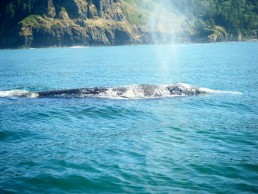Gray Whale Migration
Gray Whale Migration
Each October as the northern ice pushes southward small groups of gray whales start a two to three month 5,000 – 6,800-mile trip south. Beginning in the Bering and Chukchi seas and ending in the warm lagoons of Mexico’s Baja peninsula.
Traveling night and day the gray whale averages approximately 75 miles per day at an average speed of 5 mph. This round trip of 10,000 –13,600 miles is believed to be the longest annual migration of any mammal. By late December to early January, they begin to arrive in the calving lagoons of Baja. The three most popular lagoons are Laguna Ojo de Liebre, San Ignacio, and Magdalena.
The first whales to arrive are usually pregnant mothers that look for the protection of the lagoons to bear their calves, along with single females seeking mates. By mid- February to mid-March, the bulk of the population has arrived in the lagoons.
Throughout February and March, the first to leave the lagoons are males and females without new calves. Nursing mothers with their newborns are the last to depart. These whales leave only when their calves are ready for the journey, which is usually from late March to May.
There are approximately 25,000 gray whales during the winter and spring migrations. About 200 of these whales feed along the Oregon coast during fall and summer.
From March through June most gray whales make the journey from their breeding lagoons in Baja California to the Arctic feeding grounds. On this northbound migration, small numbers of gray whales fall out of the migration and stop at various locations along the Oregon coast. One of these places is Depoe Bay; these whales are called resident gray whales.

